People always ask me, “Can you eat them?” when they see thick mats of mushrooms growing out of our wood chip mulch after it rains.
And while these ones look quite showy and fleshy, you’d easily walk by them without a second glance.
It’s only a few millimeters wide and tall, about the size of a pinky nail. When mushrooms are young, they look like small bumps with spiky or fluted sides that are completely closed off to protect the “eggs” inside.
Bird’s nest fungi get their name from the fact that their caps break off over time to reveal a nest of eggs.
Bird’s nest fungi are a common sight in many gardens, especially in bark mulch beds Their tiny cup-shaped fruiting bodies containing lentil-shaped peridioles make them look just like little bird’s nests holding eggs. While they might seem cute and harmless, these fungi can become a nuisance if left unchecked Here’s what you need to know about getting rid of bird’s nest fungi in your garden.
What Are Bird’s Nest Fungi?
Bird’s nest fungi belong to the genus Cyathus and family Nidulariaceae. There are over 50 species found worldwide, thriving in mulch, leaf litter, soil, and rotting wood.
These fungi play an important role in decomposing organic matter. The fruiting body forms a splash cup that fills with rainwater. When raindrops hit it, the cup splashes out the lentil-shaped peridioles contained inside These peridioles stick to nearby surfaces and release spores when dried out The spores spread the fungus to new areas.
While bird’s nest fungi help break down matter in the environment, some gardeners see them as an eyesore. The numerous little nests popping up in the garden bed can look messy and overgrown. Plus, the sticky peridioles may adhere to siding or patio furniture, making them hard to remove.
When to Get Rid of Bird’s Nest Fungi
Timing is an important factor when trying to remove bird’s nest fungi. Here are the best times to implement control methods:
-
Spring: Rake up old nests in mulch and topdress beds with fresh mulch to cover any remaining fungus.
-
Summer: Periodically hand pick nests to keep the population low during warm, wet months when fungi thrive.
-
Fall: Reduce watering and rake soil to disturb fungi that emerge in cool, damp weather.
-
Before major rain: The nests swell when wet, so removing them just before a heavy rain helps minimize splashing.
Organic Methods to Control Bird’s Nest Fungi
Bird’s nest fungi are harmless to plants, so harsh chemical fungicides are not recommended. You can effectively reduce them using gentle, organic methods:
Rake Away Debris
Raking up debris like fallen leaves and twigs eliminates the food source bird’s nest fungi need to survive. Do this periodically to disrupt fungal growth.
Allow Soil to Dry Out
These fungi thrive in damp conditions. Allowing the soil to dry between waterings can help minimize their spread.
Replace Mulch
Remove old mulch completely and put down fresh mulch to cover existing fungus. Choose shredded bark or pine needles over wood chips.
Reduce Irrigation
Watering less often deprives bird’s nest fungi of the moisture they require to fruit and reproduce.
Use Groundcovers
Dense groundcover plants like ivy and vinca minor form a mat that prevents light from reaching fungi below.
Hand Pick Nests
Simply pluck away any visible nests to help keep the population under control.
Turn Compost
Regularly turning and aerating compost piles exposes fungi to less hospitable conditions.
Apply Sand Layer
Topping mulch beds with a thin layer of sand can help deter fruiting body formation.
When to Seek Professional Help
For most homeowners, bird’s nest fungi are kept in check using regular organic control methods. But if you notice an extremely excessive number of fruiting bodies popping up, it may be time to enlist some professional help.
Signs that your bird’s nest fungus problem is out of control and requires an expert’s diagnosis include:
- Nests forming at a rapid, prolific rate
- Deformed, discolored, or dying plants
- Visible fungal mats coating soil, mulch, or plant stems
- Mushrooms emerging alongside bird’s nest fungi
A professional landscaper can test your soil, identify the exact fungal species, and determine if further treatment is required. They may recommend solarizing the soil or applying beneficial nematodes to get the infestation under control.
Coexist Peacefully with Bird’s Nest Fungi
For most gardeners, bird’s nest fungi are a relatively minor nuisance. While not the prettiest addition to garden beds, they play an important ecological role. With a little diligent maintenance like raking, mulch removal, and dry periods, bird’s nest fungi are easy to manage. Think of them as a natural part of the landscape, concentrating efforts only on areas where fruiting is excessive. With the right organic approach, you can keep your garden free of mess while still allowing these beneficial decomposers to do their work.

The life cycle of bird’s nest fungus
Bird’s nest fungi are not only fascinating in appearance, but fascinating in their reproductive strategy. They multiply through the “eggs” in their cups, but not in the way you might think.
Up close, the eggs are almost metallic looking, resembling shiny river stones. They’re known as periodoles, and they serve as protective sacs for the mushroom’s spores.
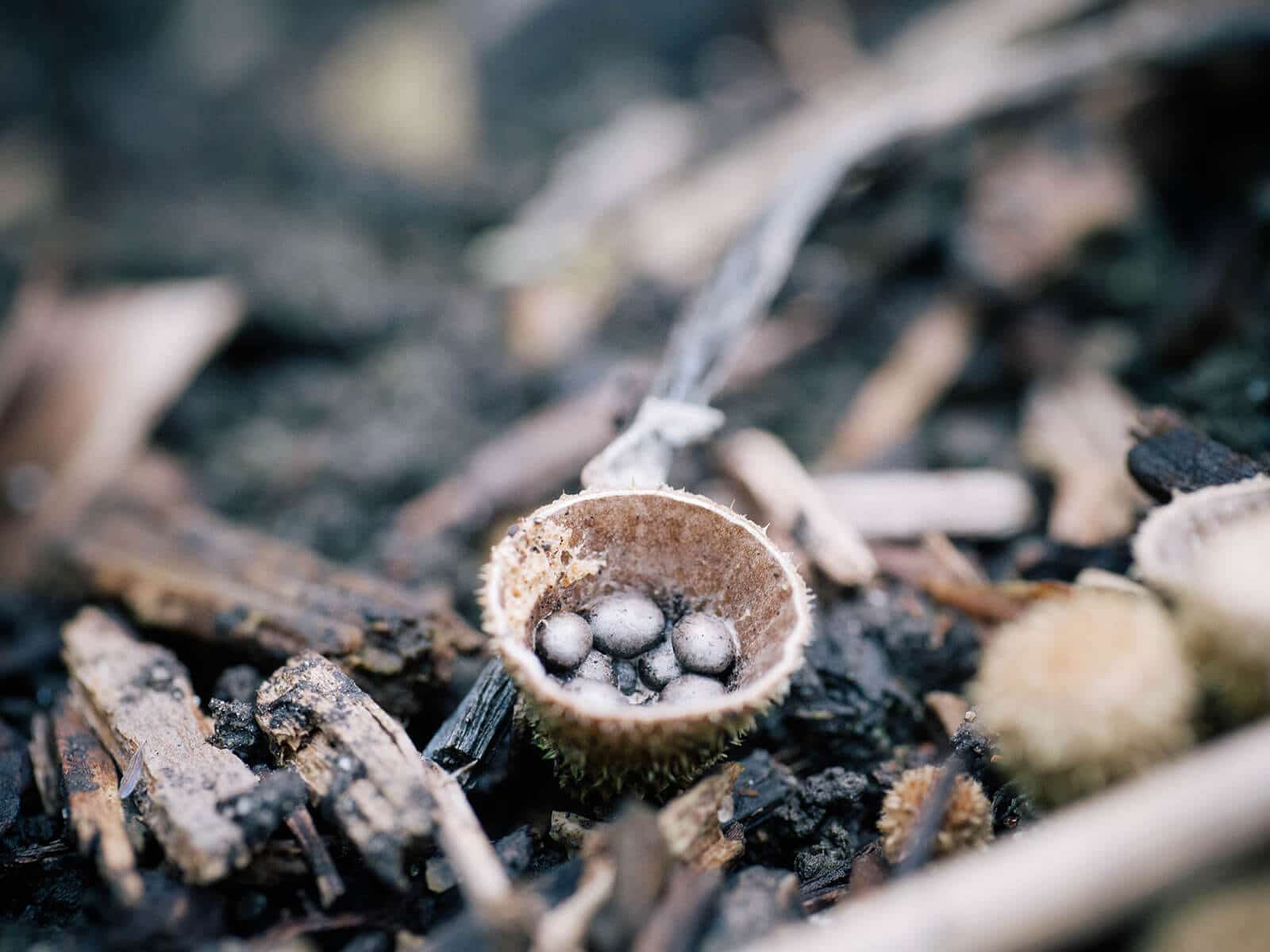
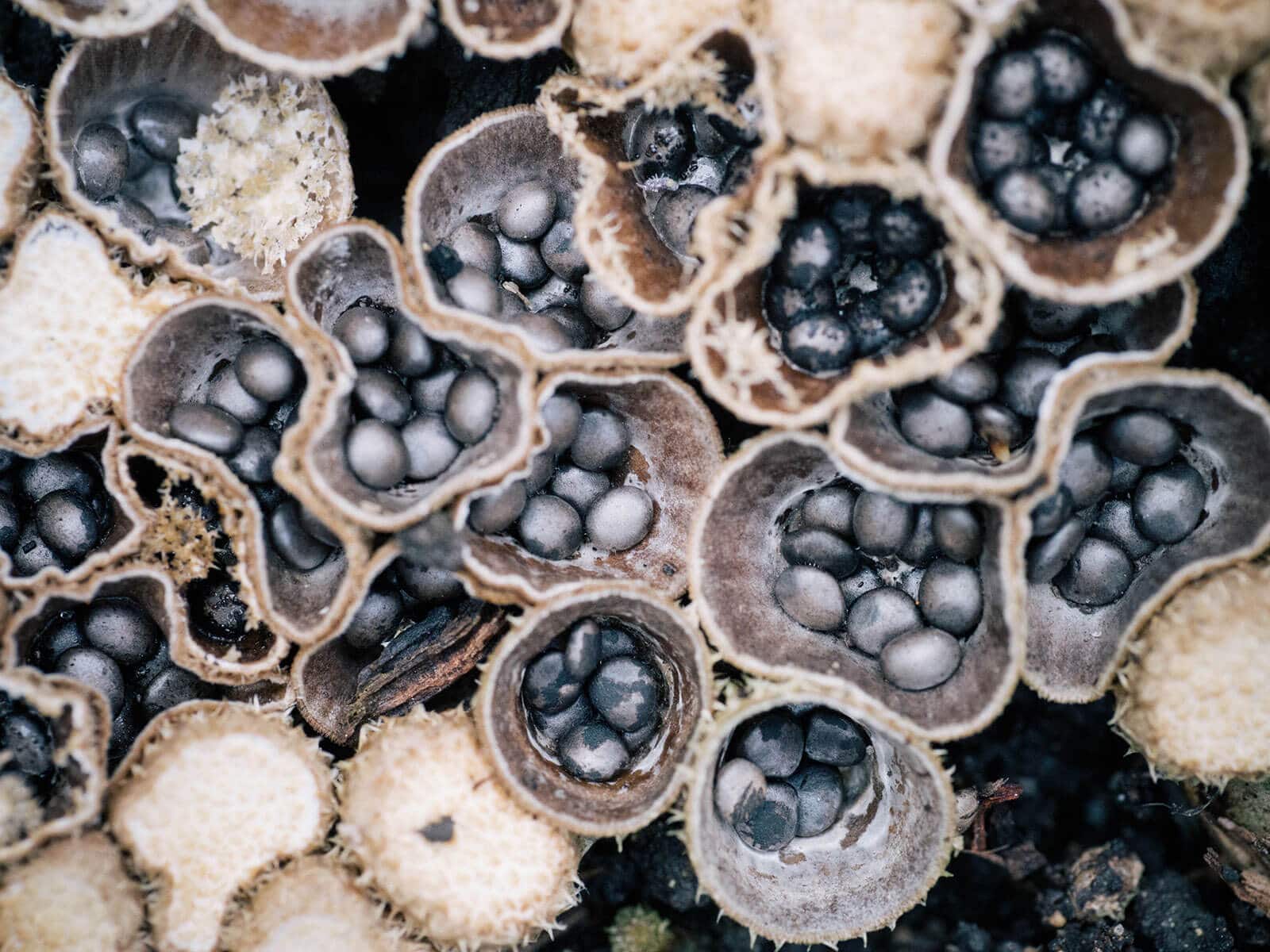
Drops of rain or irrigation water land in the cups and eject the periodoles up to four feet away, hoping to find a good place to live and reproduce.
Even a single raindrop a few millimeters across can be strong enough to shoot the periodoles off like a water cannon. This unique method of dispersal is why you’ll sometimes hear bird’s nest fungi referred to as “splash cups. ”.
This is where things get really interesting: each periodole is linked to a funicular cord, which is a long, thin thread with a sticky end that unwinds a few inches. Yes, inches. From that tiny cup!.
As the periodole flies through the air, the cord might touch something, like a grass blade or a branch. It is caught by its tail and quickly wraps around the grass, making a game of tetherball in the sky.
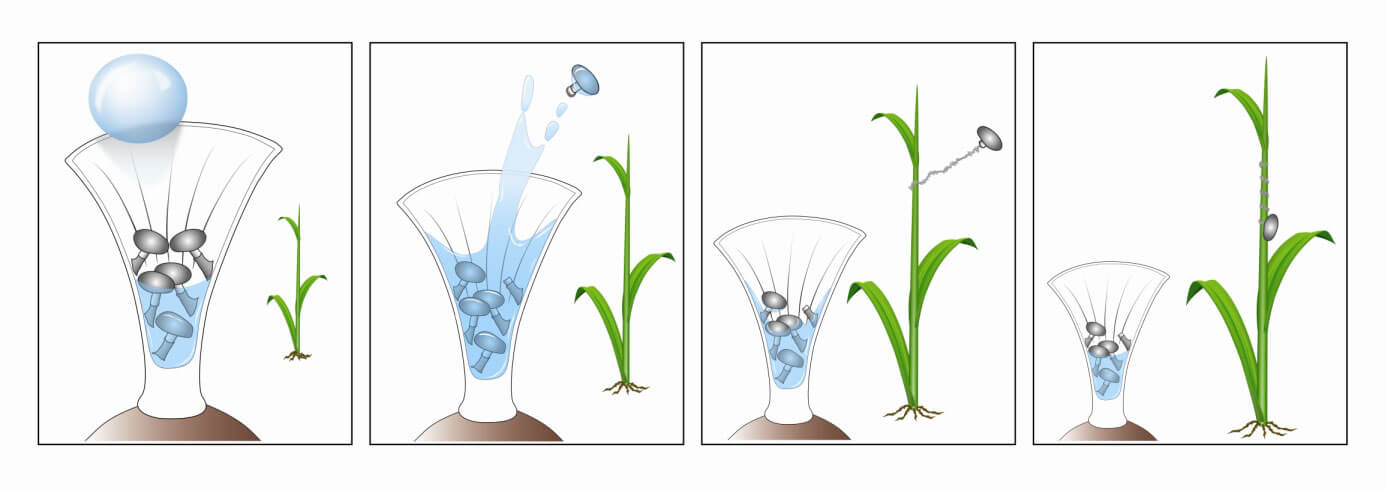
Here it remains until the periodole dries, then splits open to release the spores.
When the spores germinate, they grow into branching filaments called hyphae. The hyphae, which are grouped together to form mycelium, move through wet woody debris and eat the wood to fuel its growth.
Bird’s nest fungi are saprophytes, which are microorganisms that live on dead organic matter. This is a natural process that happens a lot when wood breaks down.
Two different types of mycelia that are mating join together to make a new bird’s nest fungus. This fungus feeds on nutrients from organic waste and breaks it down quickly, which doubles the rate of decomposition. ) This cycle usually occurs between July and October.
Bird’s nest fungi make it easier and faster to clean up plant debris in the garden by breaking up big pieces into smaller pieces that break down and add to the soil’s nutrients.

What is bird’s nest fungus?
In Chinese bird’s nest soup, the bird’s nest is made from real birds’ nests from the edible-nest swiftlet and black-nest swiftlet. The mushroom bird’s nest fungus is not the same thing.
Bird’s nest fungi are in the Nidulariaceae family and are recognized by their round, hollow fruits that look like egg-filled bird’s nests. They include Nidularia, Nidula, Mycocalia, Crucibulum, and Cyathus.
Cyathus striatus fungi are the ones that show up in my garden the most. They have sporocarps, which are flared, tan-colored cups that hold flat, dark gray “eggs” that look like lentils.
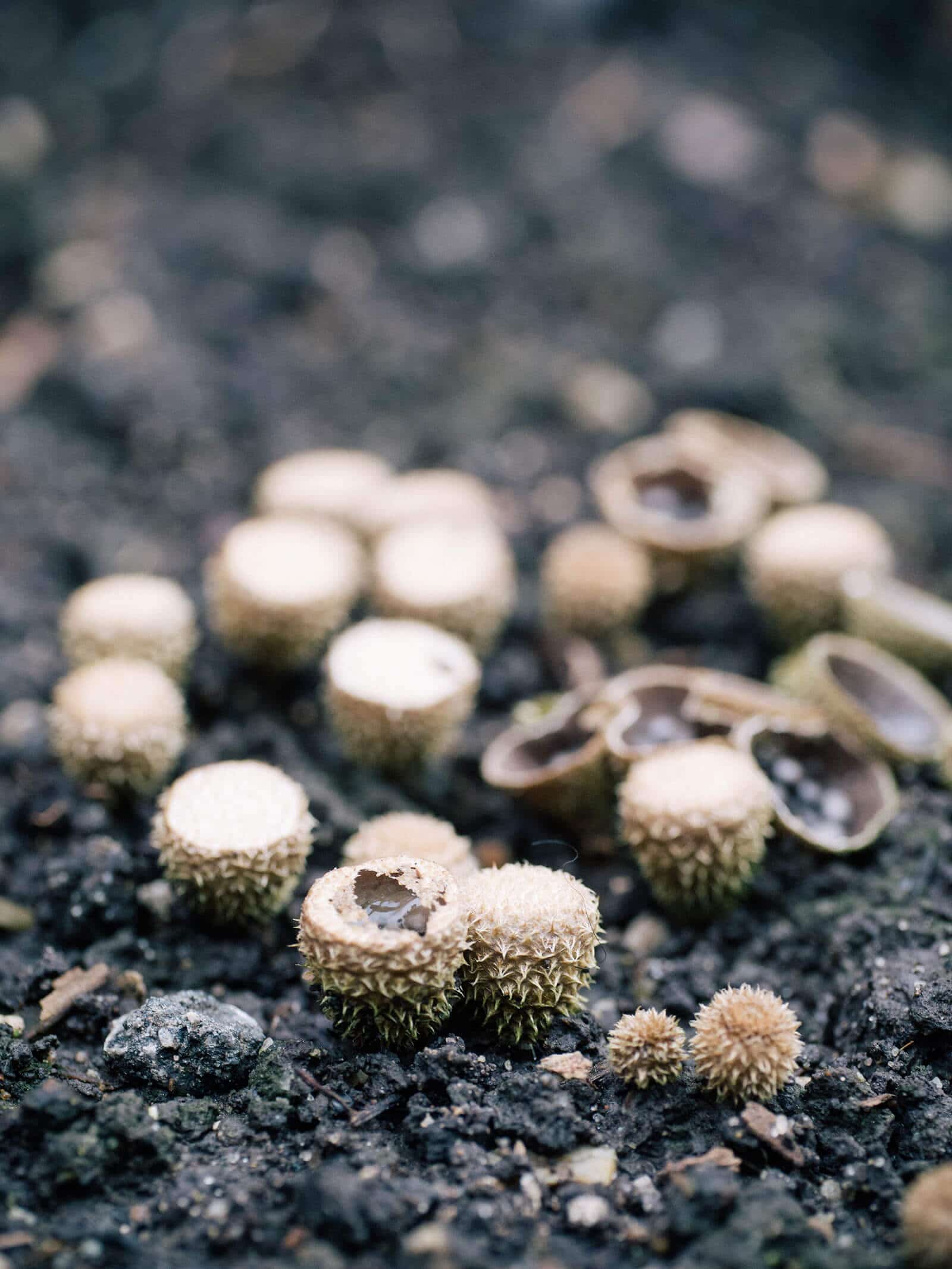
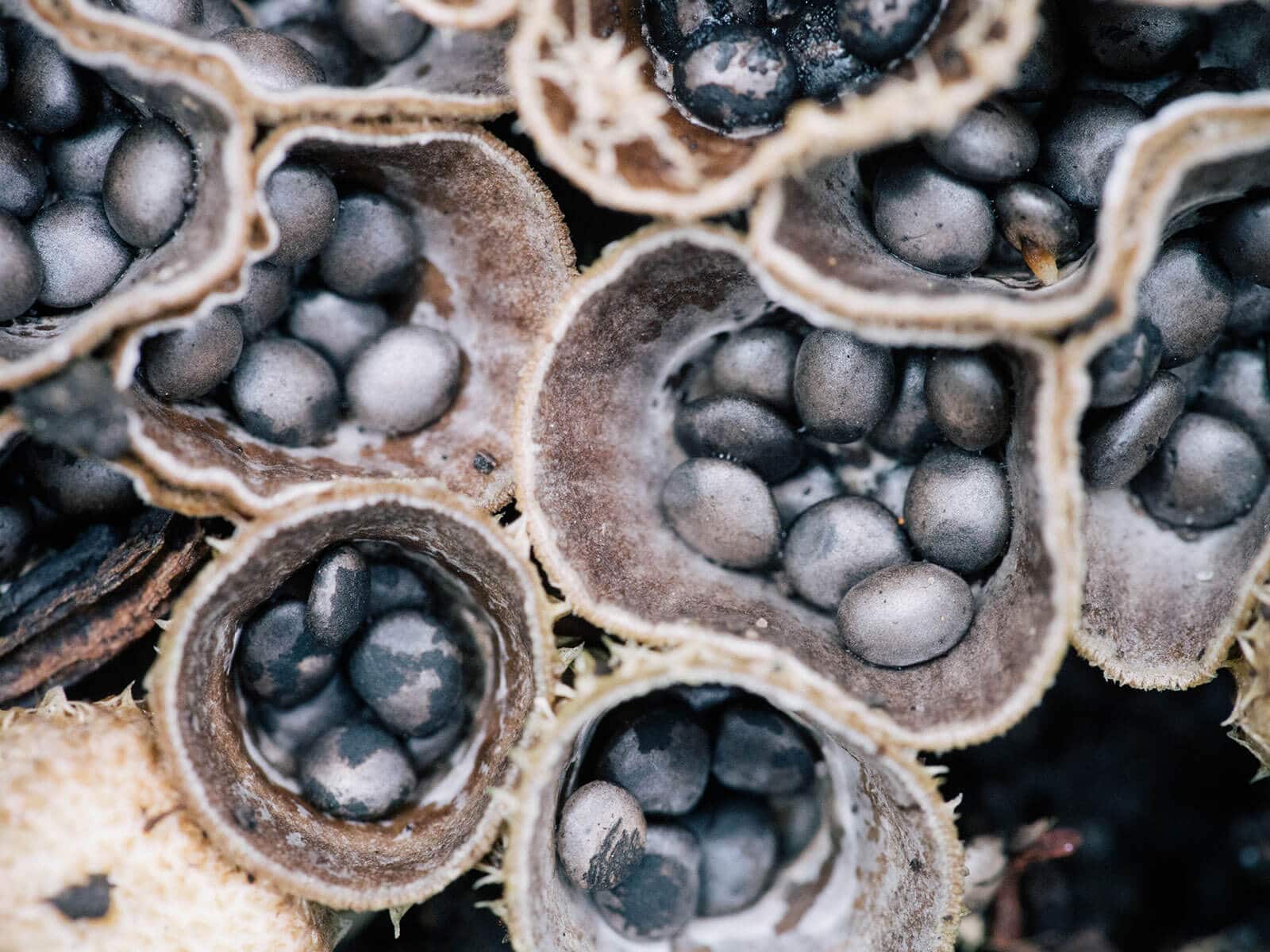
They break down food very quickly and do best in damp, wooded areas. You can often find them in shady vegetable gardens or on paths made of wooded mulch. As long as it is mild and rains every once in a while, bird’s nest fungi can spread through any dead organic matter they come into contact with.
Bird’s nest fungi grow in humus-rich soil, dead tree trunks, rotting wood, wood mulch, bark chips, sawdust, and plants that are dying. They are most common in the fall. You may even find them in animal dung, since the periodoles can make it through the digestive tracts of horses and cows.

How to Kill Bird’s Nest Fungus
FAQ
Is bird’s nest fungus harmful to humans?
Is bird nest fungus bad for plants?
What is the white fungus on my birds nest?
How to get rid of a bird nest?
Do you need to get rid of bird’s nest fungi?
Whether you need to get rid of bird’s nest fungi from your garden depends on the amount present. Of the many types of fungi you can find in the garden, the bird’s nest is among the most beneficial. It has high and natural composting abilities, the reason why you need to keep it around.
How can I get rid of toenail/fingernail fungus naturally?
Home remedies you can use to get rid of toenail fungus are using active ingredients (camphor and eucalyptus oil, ex vapo rub) may help treat toenail fungus. Second, is Tea trea oil is an essential oil with antifungal and antiseptic abilities. Paint the tea tree oil directly to your affected nail twice daily. Third, you may treat toenail fungus with garlic by placing chopped or crushed garlic cloves on the affected area for 30 minutes daily.
What is a bird nest fungus?
The cup shape is actually the fruiting body of the fungus and holds the lentil-shaped peridioles that contain the spores which are the basis of the saprophyte’s reproduction. Bird’s nest fungi in gardens are common in moist, cool locations primarily in fall. Their preferred locations are rich soil, animal feces, decaying wood, and plant debris.
How do bird’s nest fungi decompose wood?
Bird’s nest fungi are saprophytes (microorganisms that live on dead organic matter) and this natural process is largely how wood decomposes. When two different mating strains of mycelia fuse together, they form a new bird’s nest fungus that takes nutrients from organic waste and breaks it down rapidly (speeding up decomposition by two-fold.)
How does bird nest fungi work?
Life Cycle and Benefits of Bird’s Nest Fungi Bird’s nest fungi in gardens catch rain or irrigation water in the little fruiting cups, which are about ¼ inch (0.5 cm.) in diameter. The splash of the water ejects the peridioles 3 to 4 feet (1 m.), hopefully into hospitable terrain.
How do bird’s nest fungi disperse?
Bird’s nest fungi are unique in both their appearance and their dispersal mechanism. If you take a closer look, you will notice several “eggs” inside each “nest” (Figure 1). These so-called eggs contain millions of fungal spores that will disperse by splashing and grow into a new fungal individual.
- The Ultimate Guide to Growing Strawberries in Raised Beds - August 8, 2025
- No-Dig Garden Beds: The Easiest Way to Grow a Beautiful Garden - August 6, 2025
- How to Protect and Preserve Wood for Raised Garden Beds - August 6, 2025
